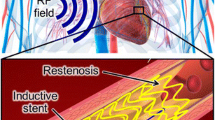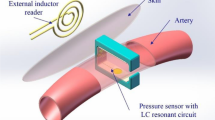Abstract
Direct measurements of arterial blood pressure most commonly use bulky external instrumentation containing a pressure transducer connected to an ex vivo fluid-filled arterial line, which is subject to several sensing artifacts. In situ blood pressure sensors, typically solid state piezoresistive, capacitive, and interferometric sensors, are unaffected by these artifacts, but can be expensive to produce and miniaturize. We have developed an alternative approach to blood pressure measurement based on deformation of an elastic tube filled with electrolyte solution. Simple measurement of the electrical conductance of this solution as the tube dimensions change allows determination of the external pressure. The sensor is made from inexpensive materials and its miniaturization is straightforward. In vitro static testing of initial sensor prototypes mounted on a catheter tip showed a linear response with applied pressure and a resolution of 1 mmHg. In vivo sensing followed catheterization of the sensor into the femoral artery of a porcine model through a 7F catheter port. The sensor performed comparably to a commercial pressure transducer also connected to the catheter port. Due to its scalability and cost, this sensor has the potential for use in a range of pressure sensing applications, such as measurement of intracranial, spinal, or interstitial pressures.




Similar content being viewed by others
References
Association for the Advancement of Medical Instrumentation, ANSI/AAMI BP22:1994 Blood Pressure Transducers, American National Standards Institute (2006)
M.M.R. Amirhamzeh, C.X. Jia et al., Systolic arterial pressure recovery after ventricular fibrillation in pigs. Ann. Thorac. Surg. 58, 1374–1379 (1994)
R.A. Chaer, S. Trocciola et al., Evaluation of the accuracy of a wireless pressure sensor in a canine model of retrograde-collateral (type II) endoleak and correlation with histologic analysis. J. Vasc. Surg. 44(6), 1306–1313 (2006)
C.-C. Chiang, C.-C.K. Lin et al., An implantable capacitive pressure sensor for biomedical applications. Sensors Actuators A-Phys. 134, 382–388 (2007)
J. Coosemans, R. Puers, An autonomous bladder pressure monitoring system. Sensors Actuators A-Phys. 123–24, 155–161 (2005)
T. Cuisset, C. Beauloye et al., In vitro and in vivo studies on thermistor-based intracoronary temperature measurements. Catheter. Cardiovasc. Interv. 73, 224–230 (2009)
T. Eggers, J. Draeger, et al., Wireless intra-ocular pressure monitoring system integrated into an artificial lens. Microtechnologies in Medicine and Biology, 1st Annual International, Conference On. 2000. Lyon, France, IEEE (2000)
B.D. Hoit, N. Ball et al., Invasive hemodynamics and force frequency relationships in open- versus closed-chest mice. AJP-Heart 273, H2528–H2533 (1997)
M. Leonardi, P. Leuenberger, et al., A soft contact lens with a MEMS strain gage embedded for intraocular pressure monitoring. TRANSDUCERS, Solid-State Sensors, Actuators and Microsystems, 12th International Conference on, 2003, IEEE (2003)
P.L. Marino, The ICU Book (Lippincott Williams & Wilkins, Baltimore, 1998)
L.K. Massey, Permeability properties of plastics and elastomers: A guide to packaging and barrier materials, 2nd edn. (William Andrew Publishing, Norwich, 2003)
B.H. McGhee, E.J. Bridges, Monitoring arterial blood pressure: what You May Not know. Crit. Care Nurse 22(2), 60–79 (2002)
A. Meir, D.S. McNally et al., The internal pressure and stress environment of the scoliotic intervertebral disc - a review. Proc Inst Mech Eng H. 222(2), 209–219 (2008)
R.D. Miller, L.I. Eriksson et al., Miller’s Anesthesia (Elsevier, Churchill Livingstone, 2009)
A. Nair, B.D. Kuban et al., Coronary plaque classification with intravascular ultrasound radiofrequency data analysis. Circulation 106, 2200–2206 (2002)
N. Najafi, A. Ludomirsky, Initial animal studies of a wireless, batteryless, MEMS implant for cardiovascular applications. Biom. Microdevices 6(1), 61–65 (2004)
J.A. Potkay, Long term, implantable blood pressure monitoring systems. Biomed Microdevices 10(3), 379–392 (2008)
R. Schlierf, U. Horst et al., A fast telemetric pressure and temperature sensor system for medical applications. J. Micromech. Microeng. 17(7), S98–S102 (2007)
U. Schnakenberg, C. Krüger et al., Intravascular pressure monitoring system. Sensors Actuators A: Phys. 110(1–3), 61–67 (2003)
Sigma-Aldrich. “Syringe Needle Gauge Chart.” Retrieved 04/05/2013, (2013), from http://www.sigmaaldrich.com/chemistry/stockroom-reagents/learning-center/technical-library/needle-gauge-chart.html
R. Tan, T. McClure et al., Development of a fully implantable wireless pressure monitoring system, Biomed Microdevices. 11(1), 259–264 (2009)
R. Tan, P. Schulam et al., Conductometric catheter-mounted pressure sensor. Medicine meets virtual reality 19 (IOS Press, Newport Beach, 2012)
M.R. Tofighi, U. Kawoos et al., Wireless intracranial pressure monitoring through scalp at microwave frequencies. Electron. Lett. 42(3), 148–150 (2006)
K. Totsu, Y. Haga et al., Ultra-miniature fiber-optic pressure sensor using white light interferometry. J. Micromech. Microeng. 15, 71–75 (2005)
P. Walter, U. Schnakenberg et al., Development of a completely encapsulated intraocular pressure sensor. Ophthalmic Res. 32(6), 278–284 (2000)
A.S. Walton, H. Krum, The Heartpod implantable heart failure therapy system. Heart Lung Circ. 14(Suppl 2), S31–S33 (2005)
Q. Wang, H.R. Brunner et al., Determination of cardiac contractility in awake unsedated mice with a fluid-filled catheter. Am. J. Physiol. Heart Circ. Physiol. 286, H806–H814 (2004)
C.-Y. Wu, W.-H. Liao et al., Integrated ionic liquid-based electrofluidic circuits for pressure sensing within polydimethylsiloxane microfluidic systems. Lab Chip 11, 1740–1746 (2011)
H.J. Yoon, J.M. Jung et al., Micro devices for a cerebrospinal fluid (CSF) shunt system. Sensors Actuators A-Phys. 110(1–3), 68–76 (2004)
D. Zhao, Y. Liao et al., Toxicity of ionic liquids. Clean 35(1), 42–48 (2007)
B. Ziaie, T.-W. Wu et al., An implantable pressure sensor cuff for tonometric blood pressure measurement. Biomed Microdevices 3(4), 285–292 (2001)
Acknowledgments
The authors would like to acknowledge the United States Army Telemedicine and Advanced Technology Research Center (TATRC) for financial support.
Author information
Authors and Affiliations
Corresponding author
Rights and permissions
About this article
Cite this article
Tan, R., Benharash, P., Schulam, P. et al. Implantable electrolyte conductance-based pressure sensing catheter, II. Device construction and testing. Biomed Microdevices 15, 1035–1041 (2013). https://doi.org/10.1007/s10544-013-9793-5
Published:
Issue Date:
DOI: https://doi.org/10.1007/s10544-013-9793-5




